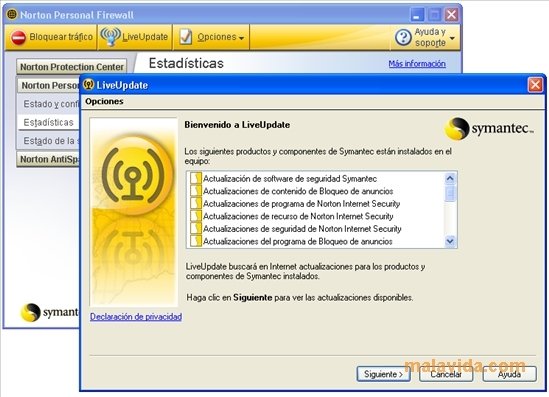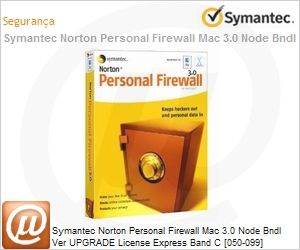-
Norton Personal Firewall For Mac카테고리 없음 2020. 1. 30. 22:50

Symantec, one of the industry leaders in disk computer utilities, has launched a new product protecting users of 'always on' broadband connections, Norton Personal Firewall.
Symantec, one of the industry leaders in disk computer utilities, has launched a new product protecting users of 'always on' broadband connections, Norton Personal Firewall. Norton Personal Firewall provides a powerful and easily configurable Firewall for protecting you computer from unwanted visitors and hackers. Norton Personal Firewall also includes a detailed log feature, allowing users to get specifics regarding online computer behavior.
Along with NPF, Symantec has also announced the availability of the Norton Internet Security suite, which includes NPF, Norton Anti Virus, and Aladdinis iClean. The suite provides online users with everything they will need to keep their computer clean and safe for harmful viruses and attacks. While the new application is a System 9.x program, it will provide Firewall security for OS Xis Classic layer. Symantec representatives told The Mac Observer that they were indeed working on OS X versions of both Norton Personal Firewall, and more importantly, Norton Anti Virus. No time table was set, but the release of system level applications will largely depend on what changes are made within OS X between now and its official release sometime in 2001.
According to Symantec: Symantec Corporation (Nasdaq: SYMC), today announced Norton Internet Security and Norton Personal Firewall for Macintosh. Norton Internet Security for Macintosh is the first Internet security suite for the Mac OS to offer a comprehensive solution with protection against Internet threats such as hackers, illegal access and viruses. Norton Internet Security for Macintosh provides an essential Internet security suite for the Macintosh platform, combining Norton Personal Firewall for Macintosh 1.0, Norton AntiVirus for Macintosh 7.0 and iClean 3.5 by Aladdin Systems.
Norton Internet Security for Macintosh 1.0 combines several world class products to ensure a controlled and safe Internet experience for all Macintosh users. Norton Internet Security for Macintosh includes Norton Personal Firewall for Macintosh to protect consumers from hackers and security breaches; award-winning Norton AntiVirus for Macintosh to guard against known and unknown virus threats; and iClean by Aladdin Systems to sweep away Web surfing tracks as well as tidy up the desktop. Together, these products provide consumers with a suite solution that intelligently balances ease-of-use and functionality for maximum usability and online protection. Norton Antivirus for Macintosh 7.0 can run disk scans and repair files on Mac OS X Public Beta hard disks after launching the application from a Mac OS 9 partition or bootable compact disk. Norton Personal Firewall for Macintosh can be installed into and will protect the Mac OS 9 or classic layer of Mac OS X Public Beta. Norton Personal Firewall for Macintosh 1.0 is an easy-to-use Internet security solution that protects connected consumers from hackers and security breaches.
Users can block connections to their machines preventing hackers from gaining access to important files, passwords, banking numbers or other confidential data stored on the computer. In addition, users can configure which applications are allowed to access their Macintosh via the Internet and are notified when an unauthorized program or user attempts to access their Macintosh from another computer. Norton Personal Firewall for Macintosh 1.0 incorporates the highly regarded DoorStop Personal Firewall, licensed from Macintosh developer Open Door Networks, Inc, which is continuing to participate in the development of this technology with Symantec. Norton Personal Firewall is available for US$69.95, while users of Net Barrier or DoorStop may 'upgrade' for US$39.95.
The Norton Internet Security suite is available for US$99.95, while users of other anti-virus or Firewall programs may 'upgrade' for US$69.95. You can find more information at the Symantec web site.
Is a nice firewall which is 10.5 compatible. My understanding is that Norton products tend to be problematic. Also, I briefly used Norton Internet Security on a Windows computer and hated the Firewall; it was impossible to get it to do what I wanted.

Little Snitch (and, for Windows, ZoneAlarm), by contrast, have very configurable rules that are easily manipulated by the user. The drawback to Little Snitch is that the rules are all 'per-user', which means that if you use more than one account (e.g.
An administrator account for administrative tasks and a non-administrative account for everyday tasks) you end up having to configure Little Snitch twice. The built-in Leopard Firewall is perfectly adequate for blocking incoming requests, but does not even try to filter outgoing requests. Filtering outgoing requests is what e.g. Little Snitch is for. Finally, for best security you should also have a hardware firewall. For most people, this just means turning on something like 'stealth mode' on your router.

If you don't have a router, it isn't a bad idea to get an inexpensive one, just for the firewall. This will then be redundant with the Leopard Firewall, (i.e. Blocks ingoing, but not outgoing, requests) but it may not be a bad idea to keep the Leopard Firewall on anyway. Started off using nothing but Norton, Disc Doctor, Disc Editor, Anti-Virus, and than the Firewall.
Haven't had problems with any of them. Still using their Anti=Virus and will probably continue to. Currently using their Personal Firewall 3.1 but that won't work with 10.5 which I am now getting a little impatient to move to. Keep trying to get Norton to commit to a yes or no about a firewall for the Mac but they keep dodging the question. Your last paragraph about the router seems to make a lot of sense.
Thank you for responding. Why block outgoing traffic? Just because you (more-or-less 🙂 ) trust the applications you have installed, doesn't mean that you want to allow them to access the internet. This, of course, depends on your level of paranoia. First of all, just because you think you have control over what is happening inside, doesn't mean you do. Adding the outgoing control may help you detect a trojan, worm, virus or spyware. (Even if, at this point, there is only one the one trojan in the wild which affects Mac OS.) But the main example is that many otherwise reputable software applications connect to their servers based on what you do.
IMHO, this raises privacy issues. For example, when you type something into Apple Help, it doesn't just search its documents on your computer for the answer. It also connects to Apple's servers with the question. Does this mean that Apple is tracking the things each user is asking, or does it just allow Apple Help to include online-only documents in the search results? I don't know. So if I'm feeling paranoid, I deny Apple Help's access to the internet.

If I think there may be useful online-only matches, then I allow Apple Help's access to the internet. If I can't imagine why an (not necessarily Apple) application's accessing the internet would possibly be useful for me, I deny it permission. If I think that an application's accessing the internet is going to do more harm than good (no! Don't autoupdate! That broke you last time!) then I deny it permission.
An even more specific example is /System/Library/LaunchDaemons/com.apple.dashboard.advisory.fetch.plist. This is part of Leopard, so it is already on the inside. But it is none of Apple's business which widgets I have in my dashboard, nor should it be up to Apple to unilaterally disable any widgets I have which, however, Apple disapproves of. On the other hand, it can be argued that this serves the useful purpose of automatically disabling any widgets which are known to be incompatible with the current OS. Since I take the former view rather than the latter view, I could disable the plist ( sudo launchctl unload -w /System/Library/LaunchDaemons/com.apple.dashboard.advisory.fetch.plist) or I can just tell Little Snitch to prevent com.apple.dashboard.advisory.fetch from successfully accessing the internet.
Best Firewall For Mac
(Both methods also allow me to change my mind later.) The advantage to using Little Snitch is that it is proactive, which means that whereas I would have had to know that com.apple.dashboard.advisory.fetch exists before I could disable it, Little Snitch says 'Hey! Dashboardadvisoryd is trying to access the internet! And so if I didn't already know it existed, I sure do now!
The final example is mail. For example, on my Win d'oh!s box, I would use M$ Outlook to check the email which arrived to the email address provided by my ISP. This was easy because I had it, but problematic because M$ Outlook is ridiculously insecure. Among its flaws is that it will display images that arrive in email. But those images are on-line, and their URLs can be used to blab to the email sender that I read the mail, when I read the mail, where I was when I read the mail, and so on.
Norton Personal Firewall Free
None of this is any of the email sender's business. And it certainly isn't something I want a spammer to know. So to combat this, I first turned off the preview pane in Outlook. Then I started a routine of 1. Launch Outlook. Click send/receive Mail.
In ZoneAlarm's popup box, click 'allow' to allow Outlook to access the internet, but without checking the 'remember this answer' box. Close Outlook once Outlook is done downloading mail.
Launch Outlook. Double-click new mail.
In ZoneAlarm's popup box, click 'deny' to prevent Outlook from downloading images. Without an outgoing firewall, this procedure would have been impossible; either I would have been forced to download the images, or I would have had to physically cut off all my internet access just to securely read mail. (Also, incidentally, this procedure failed miserably when I tried Norton Internet Security, because, unlike ZoneAlarm, the Norton firewall was incapable of recognizing when Outlook had or had not closed, which meant that in step 3 Norton would continuously ask me if Outlook could access the internet, which meant that by the time I had convinced Norton to let Outlook access the internet, Outlook would have timed out, so I never got to check that particular email address while Norton was installed.). If you get good at the ipfw syntax, you can utilize it as your socket based firewall if you want to block on the egress. You can issue the commands from the terminal until you get a good ruleset going, then incorporate it into the machines boot sequence. I have a pretty good outbound block (port based) and I have been able to have full control over my outbound packets without having annoying pop-ups on a per-application basis. Between Leopard's app firewall and ipfw at the socket level, you've got some of the most robust, yet non-intrusive options available without spending a dime.
Norton Personal Firewall For Mac Free
Hope this helps. Apple Footer.
This site contains user submitted content, comments and opinions and is for informational purposes only. Apple may provide or recommend responses as a possible solution based on the information provided; every potential issue may involve several factors not detailed in the conversations captured in an electronic forum and Apple can therefore provide no guarantee as to the efficacy of any proposed solutions on the community forums. Apple disclaims any and all liability for the acts, omissions and conduct of any third parties in connection with or related to your use of the site. All postings and use of the content on this site are subject to the.
